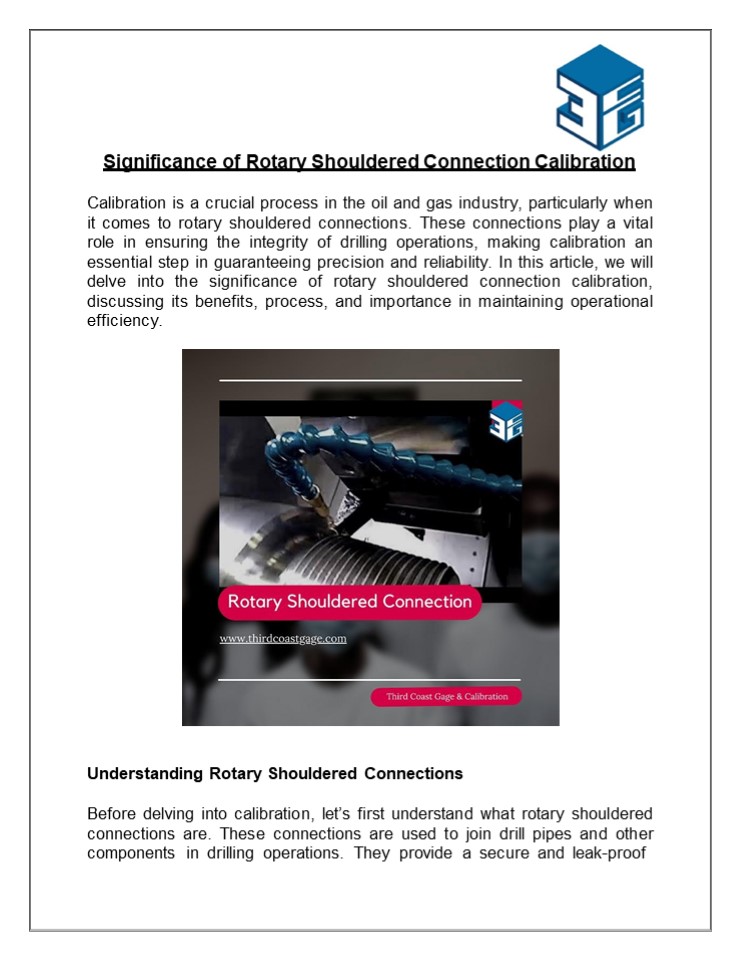Significance of Rotary Shouldered Connection Calibration - PowerPoint PPT Presentation
Title:
Significance of Rotary Shouldered Connection Calibration
Description:
Calibration of rotary shouldered connections is a critical aspect of maintaining operational efficiency and safety. By calibrating these connections, operators can ensure that they are operating within the specified tolerances, minimizing the risk of failure or leakage. Regular calibration also helps to identify potential issues early on, allowing for timely corrective actions and preventing costly downtime. – PowerPoint PPT presentation
Number of Views:2
Title: Significance of Rotary Shouldered Connection Calibration
1
Significance of Rotary Shouldered Connection
Calibration Calibration is a crucial process in
the oil and gas industry, particularly when it
comes to rotary shouldered connections. These
connections play a vital role in ensuring the
integrity of drilling operations, making
calibration an essential step in guaranteeing
precision and reliability. In this article, we
will delve into the significance of rotary
shouldered connection calibration, discussing
its benefits, process, and importance in
maintaining operational efficiency.
Understanding Rotary Shouldered
Connections Before delving into calibration,
lets first understand what rotary shouldered
connections are. These connections are used to
join drill pipes and other components in
drilling operations. They provide a secure and
leak-proof
2
connection, ensuring the efficient transfer of
torque and weight during drilling processes.
However, to ensure optimal performance, these
connections must undergo periodic
calibration. The Importance of
Calibration Calibration of rotary shouldered
connections is a critical aspect of maintaining
operational efficiency and safety. By calibrating
these connections, operators can ensure that
they are operating within the specified
tolerances, minimizing the risk of failure or
leakage. Regular calibration also helps to
identify potential issues early on, allowing for
timely corrective actions and preventing costly
downtime.
The Calibration Process The calibration process
for rotary shouldered connections involves
measuring various parameters to ascertain their
conformance to industry standards and
specifications. Heres an overview of the key
steps involved 1. Visual Inspection The first
step in calibration is a visual inspection of the
connection. This involves examining the threads,
seals, and shoulders for any signs of wear,
3
- damage, or deformities. Visual inspection helps
identify any visible defects that may require
further attention. - Measurement of Key Parameters
- The next step is measuring critical parameters of
the connection, such as thread profile, pitch
diameter, and shoulder face. Specialized tools
and gauges are used to ensure accurate
measurements. These measurements are compared
against the manufacturers specifications to
determine if the connection is within acceptable
limits. - Torque and Load Testing
- In addition to measurements, calibration also
involves torque and load testing. This helps
determine the connections ability to withstand
the forces and stresses encountered during
drilling operations. By subjecting the
connection to simulated loads, operators can
assess its performance and identify any
potential weaknesses. - Documentation and Record-Keeping
- Lastly, all calibration activities should be
thoroughly documented and recorded. This
includes detailed measurements, test results, and
any corrective actions taken. Maintaining a
comprehensive calibration history allows for
better traceability and helps in identifying
trends or patterns that may require further
attention. - Benefits of Rotary Shouldered Connection
Calibration - Calibrating rotary shouldered connections offers
several significant benefits to drilling
operations - 1. Enhanced Safety
4
- safer working environment for operators and
reduces the potential for costly incidents. - Optimized Performance
- Precisely calibrated connections ensure optimal
load transfer and torque transmission, resulting
in improved drilling efficiency. By fine-tuning
the connections, operators can maximize
operational performance and reduce energy waste. - Cost Savings
- Calibration helps identify potential issues
before they escalate into major problems. This
proactive approach reduces downtime, maintenance
costs, and the need for unscheduled repairs. By
investing in regular calibration, operators can
achieve substantial cost savings in the long run. - Conclusion
- Rotary-shouldered connection calibration is a
fundamental process in the oil and gas industry.
By ensuring precision and reliability,
calibration contributes to enhanced safety,
optimized performance, and substantial cost
savings. Regular calibration of these connections
is an indispensable practice that ensures
uninterrupted drilling operations and mitigates
potential risks. By prioritizing calibration,
operators can uphold operational excellence and
achieve long-term success in the ever-demanding
oil and gas sector. - To Know More Visit www.thirdcoastgage.com































